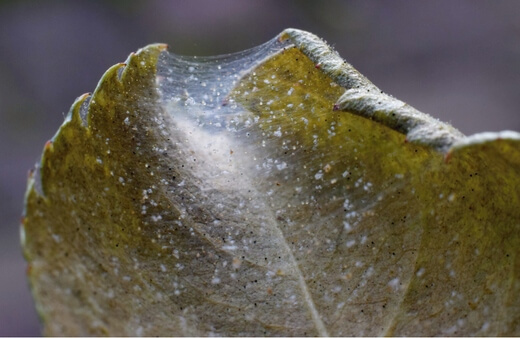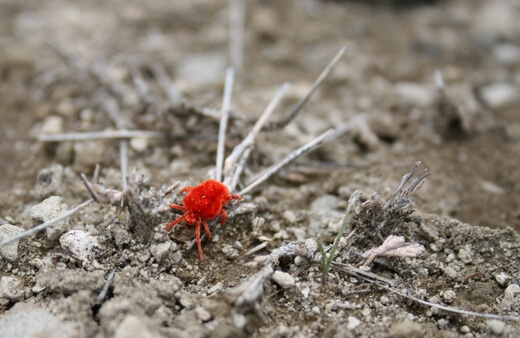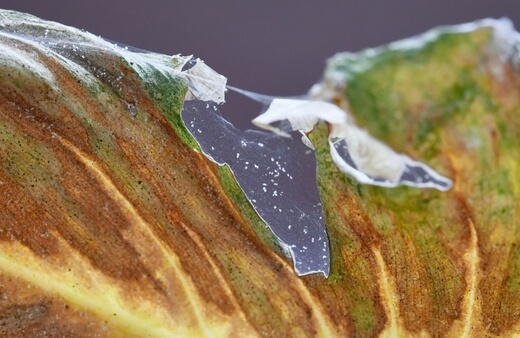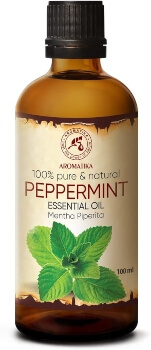Spider mites are frustrating pests, which are hard to spot, and challenging to get rid of. However, there are ways to manage them, and discouraging them through managing plant health and growing conditions will have a big impact on the scale of the problem.
Follow our guide for everything you need to know about these tiny garden pests. From details on their lifecycle, right through to how to treat and prevent spider mites on your houseplants and out in the garden.
More...

Genus: | Tetranychus |
|---|---|
Species: | urticae |
Common Names: | Spider mite, red spider mite, two-spotted spider mite, etc. |
Type: | Herbivorous arachnid |
Size: | 0.2-0.5mm |
Key features: | red, black or brown, eight-legged insects |
Colour: | Red, Black or Brown |
Effects: | Causes fungal problems due to leaf damage |
Prevention: | Predators, Deterrent plants, Organic pesticides |
What are Spider Mites?

Spider mites are part of a family of arachnids containing 1200 different species, but the most common are the red spider mite and the two-spotted spider mite. Both cause identical damage to plants but look slightly different.
Spider mites are arachnids, so are related to spiders, but spiders are carnivorous insects, feeding on flies and using their webs as a trap. Spider mites spin webs, but use them to protect their eggs from predators and the elements.
These tiny pests are usually about 0.4mm from head to tail but can be as small as 0.2mm, or as large as 0.6mm. It is unusual to see a heavy infestation of crawling spider mites, but they do live in quite large colonies in most circumstances.
Spider Mites' Natural Habitat
Spider mites are evenly spread across the entire planet and can survive extreme freezing temperatures. They thrive in dry soil but can cope with moisture.
Spider Mite Life Cycle
Spider mites lay small eggs in a repeating cycle throughout the year. Each spider mite lives for between 2-4 weeks, laying up to 20 eggs per day. That’s over 500 eggs laid by a single mite over its lifetime.
Their rapid reproduction makes them heavily capable of resisting pesticides and evolving environmental protections within colonies, making for localised traits. However, some organic pesticides we’ll explore later have never evolved out of spider mites. Due to their physiology.
What Plants Do Spider Mites Affect?
Spider mites can feed on any plant, but prefer those with less scent, and dislike plants high in essential oils. Waxy-leaved plants can really suffer with spider mite populations, particularly succulents, which store masses of moisture in each leaf.
Spider mites will also feed on thin-leaved plants and annuals like tomatoes and peppers, particularly in warm greenhouses or in full sun where the soil dries out regularly.
How to Identify Spider Mites
Spider mites are less than 1mm in size, and very difficult to see with the naked eye. They move quickly and hide in minute crevices in stones and soil so are virtually impossible to remove by hand.
With over 1200 species of spider mites, their colouring does vary, but the most common are a vivid red colour.

How to Spot Spider Mites
The easiest way to spot spider mites is their silk. Heavy infestations will have strings of silk running between leaves, without any indication of concentric circles (unlike larger spiders’ webs).
The drooping silk can cause fungal problems by trapping moisture around foliage. Less established colonies will also show clumps of silk webbing around the base of the underside of a leaf, near the stem.
Spider mites attach their eggs to the base of a leaf through spring and summer, so when their eggs hatch, they have instant access to food.
Where to Find Spider Mites on Plants
Spider mites tend to congregate on stems, and around the midribs of plant leaves, where the xylem and phloem cells transport water and chlorophyll, which is their main food source.
Signs of Spider Mite Damage on Plants
If there are clusters of orange or yellow spots on the top of a leaf, check the underside of the leaf. There are often darker lesions beginning to develop. This is where the spider mite bites into the plant to suck out chlorophyll, and fungal spores can take hold, as well as bacteria.
These lesions rapidly limit the ability of plants to photosynthesise and will cause stunted growth.
What Causes Spider Mite Infestations

There are two key causes of spider mite infestations, but they can still crop up when you least expect it even on perfectly kept plants. To limit the risk of a spider mite infestation, especially on indoor plants, focus on keeping the soil evenly moist, and following a strict feeding regime for your plants and houseplants.
Dry soil
Spider mites are more prominent in dry months. Dry soil allows them to move between plants, and they instinctively seem to know when a plant is struggling, as it will have a weaker cell structure that makes it easier for them to bite into, despite its lower moisture levels.
House plants and drought-tolerant crops are particularly susceptible to spider mites for this reason, so proper irrigation is essential.
Overfeeding
Overfeeding any plant will also boost the population of spider mites. The more nutrients you give a plant, the more is available to spider mites. Like most pests, they know the difference between an overfed plant and a healthy plant and know that those plants have nutrients to spare.
How to Prevent Spider Mites
Spider mites can be present in soil from potted plants bought from garden centres, and in compost. The only way to completely ensure there are no spider mites present at the start of a growing season is to sterilise your growing space pots and use sterilised compost.
Insect traps and sticky traps can limit existing problems but there are very few plants that will work as natural deterrents.

What Plants Prevent Spider Mites
I’ve always read that plants high in essential oil will deter spider mites, but in practice, it just doesn’t work. Marigolds and mint do seem to have a good deterrent effect, but other plants like rosemary and lavender, which should put them off, have never worked for me.
For reference, I’ve got a happy healthy rosemary, in well-drained soil that stays reasonably moist, without being sodden. Every year, there is a colony of spider mites that emerges from the soil right next to it.
Find out more about Marigolds, it's varieties, and how to grow them here in Australia.
Organic Spider Mites Prevention
Like any pest problem in the garden, spider mites are best dealt with by nature. Encouraging beetles and predatory mites into the garden will put a stop to severe infestations.
You can do this by leaving piles of logs and twigs, or mulching under trees to provide shelter for common spider mite predators over winter.
How to Care for Plants to Prevent Spider Mites
Before I get into the plant care section, I want to caveat it with this; spider mites can live in moist conditions… they just don’t like it.
Spider mites are much less likely to occupy a patch of damp or well-watered earth, so keeping your plants well-watered will help reduce spider mites to a point that they aren’t a severe problem.
This one simple measure will go a long way to reducing their prevalence in your garden.
How to Get Rid of Spider Mites
The Best Spider Mite Treatments & Organic Killers
1. Aromatika Peppermint Essential Oil

Source: amazon.com.au
Peppermint essential oil should be in every shed in the country. Pretty much every pest hates it and will be put off instantly by its powerful aroma.
Spider mites are heavily deterred by peppermint, but it will not be 100% successful. For a completely natural and organic option though, there is nothing else that works quite as well as peppermint oil against spider mites.
Pros
Cons
2. Yellow Sticky Fly Trap

Source: amazon.com.au
Spider mites, believe it or not, are not the world’s cleverest creations, and are attracted to anything they can club up. That makes them particularly easy to catch with a sticky trap inserted into the soil next to your most precious plants.
Again, sticky straps are never 100% successful, and they will need replacing regularly, but in spring when eggs emerge from the soil, spider mites are more likely to crawl up on these traps, which will reduce the colony size before they begin to breed.
Pros
Cons
3. Harris Diatomaceous Earth

Source: amazon.com.au
Diatomaceous earth is a natural product, made from ground sedimentary rock formed from crushed algae, usually from old freshwater alluvial sites. The powder has an extremely high silica content, and won’t harm your soil.
Silica, the same stuff you find in little bags with your new shoes, is a desiccant, which helps to draw in moisture, and dehydrates whatever it comes into contact with. When it’s fully hydrated, the diatomaceous earth releases moisture and helps to manage humidity.
Applied directly to spider mites, it will dehydrate and kill them almost instantly. Applied to soil, it can dehydrate eggs, but is slightly less successful against spider mites this way.
Pros
Cons
DIY Spider Mite Treatment

Peppermint sprays, applied to the soil work well, but one of the most effective DIY treatments for your most prized plants is actually Vaseline (or any unscented petroleum jelly).
Simply rub Vaseline over the stems of your plants and spider mites will struggle to climb them, and certainly won’t be eating that part of the plant.
Only do this on the lower parts of the plant, and avoid touching foliage, as the oil will lock in moisture and prevent the leaf from breathing, causing fungal problems. This might be fiddly, but it really does work.
Final Tips for Dealing with Spider Mites
Spider mites are many things, but being strong isn’t one of them. If you notice spider mites on your plants, spray them with a high-pressure hose. Not only will this wash them off, but they’ll quickly scurry away to a dryer patch of soil afterward too.
Repeating this in the morning once a week through summer will go a long way to limiting spider mites. For me, it has to be a combination of everything above though.
Spider mites are hard to get rid of, but combining mint plants, moist soil and a more balanced mix of planting to encourage predators work well.
Spider Mite Frequently Asked Questions

Can spider mites bite humans?
Spider mites can bite humans, and often do. However, this is by mistake or in response to an immediate threat and the resulting rash will be absolutely tiny. Spider mites don’t carry diseases, and won’t bite deep enough to infect the bloodstream.
Can spider mites live in your bed?
While spider mites and dust mites look the same and act in similar ways, they are not capable of living in each other's environment, so no, spider mites do not live in your bed, and will not colonise your home. They need plants to live and do not feed on dust, hair, or skin.
What do spider mite eggs look like?
Spider mite eggs are hard to spot as they are almost always covered with a layer of fine silk. Their eggs are 0.1mm across and translucent until the nymphs begin to develop and they will become a creamy white colour.
Do spider mites spread quickly?
Spider mites lay up to 20 eggs a day, and spread incredibly quickly. A single spider mite carried into the house on clothing can colonise a houseplant within a week.
Get Rid of Spider Mites Once and For All
Spider mites are incredibly hard to get rid of, so the best treatment is a long-term plan to diversify your garden wildlife. Encourage beetles, predatory mites, and thrips, which feed on spider mites and their eggs.
Remember though, that the best way to treat and prevent spider mites is to keep your plants and growing areas clean, and well-watered.
Published on November 4, 2022 by Gary Clarke
Last Updated on April 4, 2024




